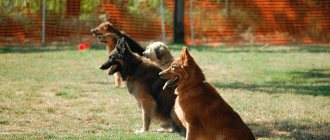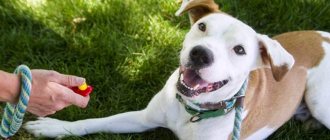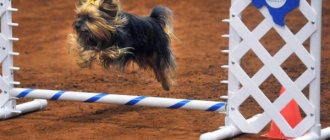The general training course (abbreviated OKD) is a dog training program developed by the domestic dog handler Vsevolod Vasilievich Yazykov in the 1920s. Since that time, the course has remained virtually unchanged, only occasional amendments have been made.
Any dog needs some form of general training. In the process of training, the animal develops obedience and a number of other useful skills that are useful both in everyday life and in professional activities. In most cases, dogs that have not passed the OKD are not allowed to participate in other types of training.
To complete a general dog training course, you can enroll in classes at a local dog training school or contact a private specialist. You can also train your pet on your own, but in this case you will need to find a suitable site, carefully read the rules and regulations for OKD, find out the dates of exams and agree with the instructor.
Let's look at which teams are included in the OKD exam and how to pass the tests successfully.
Preparation for OKD
It is recommended to train your dog 2 times a day before feeding .
The duration of each workout should be no more than 2 hours .
over the age of 12 months are allowed to take the OKD exam .
For the exam, the dog must know the basic commands “Sit”, “Lie down”, “Come to me”, etc.
The number of commands studied in one lesson depends on the preparation of the animal and its level of performance. Usually at first it is enough to study and repeat 2 commands, in the future their number should be increased.
Self-training a dog
Some breeders still choose independent training, arguing that it is a desire to save money or to entrust the dog to a stranger. But is it possible to undergo OKD without a trainer no less effectively than with one?
It is quite possible to teach a domestic dog OKD on your own.
The result of education depends on two factors:
- dog's intelligence. If a dog has good mental abilities from birth, he will quickly understand what his owner wants from him, and training will be easy and relaxed;
- persistence and patience of the owner. It is important to remember that one command will have to be repeated many times. If the owner does not have enough patience for this, training will not be successful.
It is quite possible to train a domestic dog to do OKD on your own. The exception is overly aggressive leader dogs, which are difficult to train in any way.
Who needs to take the OKD course?
What does the exam include?
during the general training course exam :
- movement of the dog next to the owner (assessed throughout the entire test period);
- display of teeth and the dog's attitude towards the muzzle;
- a set of commands “Sit”, “Lie down”, “Stand”;
- the dog’s approach to the owner and return to the place;
- aportation;
- stopping unwanted actions (command “Fu”, refusal to take food from a stranger);
- overcoming a set of obstacles (barrier, stairs, boom, fence or inclined wall);
- attitude towards the shot.
Skill testing can be carried out in any order, with the exception of commands running as a complex.
Minimum score table
Based on the results of passing the OKD for dogs, diplomas of various degrees are issued (or the exam is not counted):
| Skill | Evaluation of the dog's performance | |||
| Highest score – 100 points | Diploma 1 – 90 points | Diploma 2 – 80 points | Diploma 3 – 60 points | |
| "Near" | 10 | 9 | 8 | 6 |
| "To me" | 10 | 9 | 8 | 6 |
| "Place" | 10 | 9 | 8 | 6 |
| Complex commands | 10 | 9 | 8 | 6 |
| Importation | 10 | 9 | 8 | 6 |
| Prohibition of taking food and objects | 10 | 9 | 8 | 6 |
| Reaction to the sound of a gunshot | 10 | 9 | 8 | 6 |
| "Show your teeth" | 10 | 9 | 8 | 6 |
| Overcoming obstacles | 10 | 9 | 8 | 6 |
| Dog activity, general impression | 10 | 9 | 8 | 6 |
For each skill you can get a maximum of 10 points, penalties for performing each of the commands are prescribed in the OKD standards.
Team “Nearby”
On the command “Near”, the dog must walk to the left of the owner so that its shoulder is at the level of his leg.
You can find out how to teach this command by reading a separate article on our website - How to teach a dog the “Near” command.
How is a skill tested in the exam? The trainer gives the command “Nearby” with his voice, and then, at the judge’s signal, makes turns on the spot: right, left, around. Next comes the movement, during which the judge checks the dog’s work when changing the pace and direction of walking, as well as when stopping. The animal should walk calmly, and during stops sit at the owner’s left leg without the command “Sit”.
If the dog deviates to the side by more than 2 m, refuses to sit down, or does not make turns, then the judge does not count the skill.
Command “Come to me”
“Come to me” is one of the main commands that should be instilled in an animal from an early age.
You can find out how to teach this command by reading a separate article on our website - How to teach a dog the “Come to me” command.
How is a skill tested in the exam? The trainer gives the command “Come to me” with his voice, accompanying it with a gesture. The dog should immediately run up to the owner and sit at his left leg (it is not necessary to walk around). The animal may be seated in front of the owner. In this case, the trainer additionally commands “Next”, and the dog sits on the left.
When calling your pet after the “Walk” command, before the “Come to me” command, you are allowed to call out to the dog in order to attract its attention. Then the approach time is counted from the moment the command “Come to me” is given, and the score does not decrease.
If the dog does not approach the trainer within 15 seconds, the skill is not counted.
Team “Place”
When training puppies on the command “Place”, the dog is taught to go to its bed. In OKD, the “place” is any object familiar to the dog.
You can find out how to teach this command in the article - How to teach a dog the “Place” command.
How is a skill tested in the exam? The trainer gives the command “Lie down”, places a thing in front of the dog, and then orders “Place” and moves away 15 m. After 30 seconds, the owner calls the animal with the command “Come to me” and with a gesture. Next comes a holding period of 15 seconds, after which the trainer commands “Place” and with a gesture sends the dog to the starting position. The pet must quickly run up to the owner, return to its place and lie down within 1 m of the item. Then the owner approaches the dog and gives the command “Sit”.
If the dog does not return to its place or lies down at a distance of more than 2 m from the object, the skill is not counted.
Accessories required for passing
When practicing initial training skills, you need: 2 leashes, a long one up to 2 meters and a short one, a collar or harness, a muzzle. It is also good to have a bag with a treat for reward, a toy for fetch, and a rug that will determine the place.
You need to start OKD classes from the first days your pet arrives in the house. Obedience skills are necessary for dogs of all breeds, small and large. What degree of difficulty to choose is up to each individual to decide. But in order to be included in the list of dogs eligible to serve in law enforcement agencies, having an OKD diploma is mandatory.
A set of commands “Sit”, “Lie down”, “Stand”
The dog should be able to perform the commands “Sit” and “Lie down” already at the age of 6 months. The “Stand” command is more complex and its execution must be reinforced for up to 9 months.
You can find out the principle of training in the articles - Command “Sit”, “Lie down”, “Stand”.
How is a skill tested in the exam? The owner orders “Sit”, moves away from the dog 15 m and, using commands given simultaneously by voice and gestures, forces the dog to lie down, stand up and sit down again. Each skill is demonstrated 2 times from different positions.
At the first command, the animal must take the desired position and not change it. Moving forward more than 5 m is regarded as failure to perform the skill. Repeated submission of commands is considered an error and will reduce the score.
“Aport” command
Most dogs master the “Fetch” command without problems, perceiving it as a game.
You can find out how to teach this command in the article - How to teach a dog the “Fetch” command.
How is a skill tested in the exam? The dog stands at the trainer's left leg. He shows her the fetching object, gives the command “Sit” and throws the object forward, at a distance of at least 10 m. Then there is a short delay of about 10 seconds, after which the owner commands “Fetch” using voice and gesture. The dog must run up to the object, take it, quickly return to the owner and sit at his left leg. After some patience, the owner says the command “Give”, and the pet gives the item.
If the dog does not respond to the “Fetch” command, does not bring the object, throws it halfway, plays with it, drops it, and then picks it up again or does not give it to the trainer, the skill is not counted. Also, the command is considered unfulfilled if the pet approaches the owner only on the command “Come to me” and sits at his leg on the command “Sit”. The dog must bring the object and sit down without additional commands.
Why is it worth taking a general training course?
On the street you can often see a picture where a large dog frantically pulls its owner along with it, rushes after cats, shows aggression towards other dogs, and sometimes passers-by. Sometimes in the park you can see the owner, confused, rushing around in search of a runaway pet or starting to scream, unsuccessfully repeating the same command for the hundredth time. The result of disobedience can be frightened children, quarrels with people around them, owners of other dogs, because it happens that such situations end in conflict between animals, fights with them causing serious injuries to each other. Quite tragic cases occur if a dog jumps out onto the roadway.
A general dog training course is needed in order to eliminate such situations. During classes, the owner learns to give commands correctly and clearly, and the dog, in turn, learns to carry them out. Under the guidance of a dog handler, the owner of the animal learns to interact with him and control the dog with just his voice or hand movement. All commands are carefully practiced until the dog fully assimilates them. It is complete obedience that will allow you to avoid all sorts of problems and troubles in the future, and will turn walks into a pleasant pastime, and not a complete hassle.
Stopping unwanted activities
To stop unwanted actions, use the command “Fu” (“No”, “No”).
You can find out the training scheme in the article - How to teach a dog the “Fu” command.
During the exam, the skill is tested in one of the following ways:
- prohibit the dog from taking food from the owner’s hands;
- prohibited from taking any item.
In the first case, the trainer commands “Sit”, then treats the dog with a treat several times with an open palm. When offering another piece, the owner says “Fu.” This is followed by holding for 5 seconds, after which the trainer removes the treat. In the second case, the owner sends the animal to retrieve the thrown object, and then commands “Fu.” After the command is completed, the item is removed. If the dog takes a treat or object, it must spit it out immediately after the prohibiting command.
If the dog does not respond to 2 “Fu” commands given in a row, the skill is not counted.
How to train a dog
Rules for following a command with treats
An animal, like a person, will perform certain actions only if it receives some kind of reward, so we will teach the animal a command with the help of various treats.
Let's start with the fact that before starting training you need to purchase a long leash and a snatch chain (a collar made from a chain).
Read the rules for choosing a collar.
In this case, the following condition must be met: there should be no anything in the open space that can distract the dog (cats, other dogs, people, vehicles, etc.).
If this condition is not met, then you will spend much more time, since the animal will be interested in contact with the above objects or animals rather than following your command.
After you have taken your pet for a walk, you should give him time to run around and splash out his energy, so that it will be easier to deal with the dog
It is important to understand that until the animal has played enough, it will not concentrate its attention on you and your voice, so strictly follow the instructions
When the animal gets tired, move back to the maximum length of the leash, then call the pet by name
The dog should pay attention to you. If this does not happen, lightly tug on the leash.
After the dog has paid attention to you, you need to clearly say the phrase “Come to me.” The phrase must remain unchanged for the dog to remember it
Many dogs immediately understand what you want from them, after which they come to you, but if the pet does not react in any way, then you need to call it with a gesture (a hand gesture when we want to give the animal some food). If after this the dog does not react, then you should pull the leash so that the dog comes up
It is important to understand that the jerk should not injure the dog, otherwise all training will come to naught
After the pet has come close to you, you should pet it, thank it and give it something tasty. After rewarding, you should let the dog go for a walk.
Such simple manipulations develop in the animal the correct reaction to spoken words. The animal will associate the phrase “Come to me” with affection and tasty food, so it will not resist.
Important! You cannot punish a dog for not following a command, otherwise an appropriate association will be developed.
Reaction to shots
A well-trained dog should not be afraid of thunder, firecrackers, gunshots or any other city noise. Many people begin to accustom their pets to loud sounds from a very early age.
You can read how to do this correctly in the article - What to do if your dog is afraid of loud noises.
The animal’s attitude towards shots is checked when performing all OKD skills, except for the “Near” and “Fetch” commands. The shot is fired from a special starting pistol at a distance of 15 m from the dog executing the command.
If the pet stops following commands, gets scared or runs away, the skill is not counted.
- OO training
Which dogs are the smartest and most trainable?
- 10.11.2015
Grades, degrees, differences
First of all, OKD has two standards: test and competition. Dogs over one year old, of any breed and size, are allowed to take part in the tests. The overall impression and quality of control of the dog when performing various elements are assessed. The dog should not show cowardly or aggressive behavior, and calmly and joyfully do what the handler orders from the first command.
The final degree depends on how many points you receive. It determines the level of training. The largest number is one hundred points, the smallest is sixty.
- from 90 to 100 - first degree
- from 70 to 89 - second degree
- from 60 to 79 - third degree
A dog with less than sixty points is considered to have failed the test. But even if such a nuisance happened, this is not a reason to panic: the OKD can be taken again, but not earlier than in a month.
Those for whom everything went well are given a diploma certified by the RKF and a token, and in the pedigree of the descendants they indicate the name of the discipline completed by the parent, indicating the assigned degree.
Only those tailed animals that have successfully passed the tests can participate in OKD competitions. This standard is slightly different from the previous one, and the work is assessed in two tests: personal and team. For those who are small in stature (42 cm or less), they came up with a mini-OKD, in which everything was adapted to their characteristics.
The winners receive medals and cups, they are also given diplomas and tokens.
The command “Show your teeth” and attitude towards the muzzle
Absolutely all dogs should know the “Show your teeth” command, regardless of whether they will pass the OKD exam or not. This skill will be useful when going to the veterinarian, brushing teeth and participating in exhibitions. Along with showing the bite, the dog's reaction to the muzzle is checked.
You can read how to teach an animal to calmly accept a muzzle in the article - How to teach a dog to wear a muzzle.
How is a skill tested in the exam? The owner approaches the judge, gives the command “Show your teeth,” then puts a muzzle on the dog and commands “Walk.” After this, the trainer calls the animal and removes the muzzle.
If the dog does not follow the command, refuses to put on the muzzle, or tries to remove it, the skill is not counted.
Required equipment
To pass the OKD, regardless of whether it is carried out with or without a coach, you will need:
- a collar in which the dog feels comfortable (of a suitable size);
- long (5-8 m) and short (1.5-2 m) leashes (it is better not to use a tape measure);
- comfortable muzzle of any type, except loop;
- an object to mark a place, usually a rug;
- aportable item;
- a bag with a long strap for treats so that your hands are free.
By working with your pet and teaching it basic skills, you will not only learn how to control the animal, but also become closer to it and begin to understand it better. Dogs, for the most part, love to learn, as it involves playing and being rewarded with treats, the main thing is to be patient and work hard.
Do you like the article? 217











